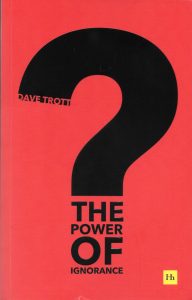The one sentence summary
If you don’t admit you don’t know what’s happening, you can never find out, and if you don’t find out, you can never change it.
Can’t be bothered to read it? Too much screen time lately? Listen to the 5-minute podcast.
WHAT THE BOOK SAYS 
- The most important step in changing anything is admitting that you don’t know. That’s the power of ignorance. Great problems solvers are not afraid to say: “I don’t know.” From that start point, they can investigate with an open mind, and often come up with some ingenious approaches. The author looks at 8 areas:
-
- What you don’t know you don’t know.
- We can’t know what hasn’t happened.
- Ignorance is a secret weapon.
- Simple is smart. Complicated is stupid.
- The power of an open mind.
- Ignorance we can fix. Stupid we can’t.
- Real ignorance beats fast knowledge.
- Thinking we know is a trap.
- People who feel secure have no need to take chances, but people who feel insecure have to take chances.
- People will judge what they need based on what their competition has.
- Semiotics is language without words. In the 1960s, Margaret Calvert designed the UK’s road signage system. She tested them by driving them at some airmen at 100mph – the context in which they would be seen. She made the complicated simple: motorways would be white on blue, A roads, white on green (with yellow numbers), and B roads black on white. Triangles for warnings; circles for commands; squares for information.
- In publishing, there is something called publication bias or the Woozle Effect (named after the Winnie-the-Pooh story in which they believe they are following a Woozle, when they are following their own footsteps). Once a journalist cites something, another takes it as fact, and it snowballs from there, but it might not be true.
WHAT’S GOOD ABOUT IT
- “The wise man knows he doesn’t know. The fool doesn’t know he doesn’t know.” Lao Tzu
- “In the West they only respect experts. But the expert mind is the closed mind.” Shunryu Suzuki
- “Misbehaviour is very strongly correlated with and responsible for creative thought.” Steve Wozniak
- In the clarity of desperation, your position is so bad that you think much more intelligently and clearly than when things are reasonably easy.
- Data may be a fact, but it isn’t necessarily the truth.
- In the Texas Sharpshooter Fallacy, a Texan who wants to be known as a crack shot blasts away at the side of a barn with two pistols. By painting a target around random clusters, it looks like he hit the target quite a few times. Our minds naturally seek patterns – we make the facts fit the thinking, which is how conspiracy theories work.
WHAT YOU HAVE TO WATCH
- As usual the author has a cornucopia of brilliant anecdotes to demonstrate his point.
